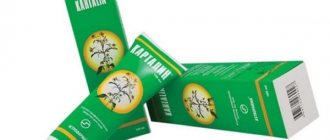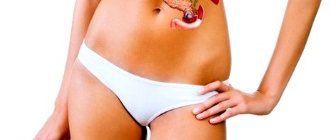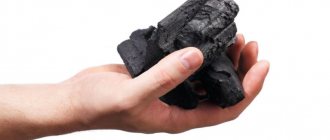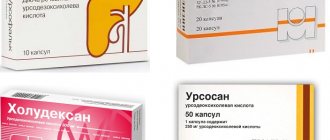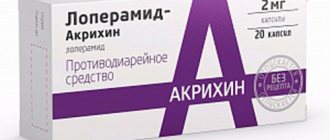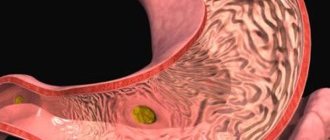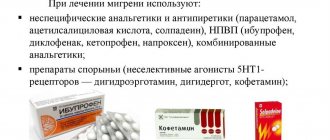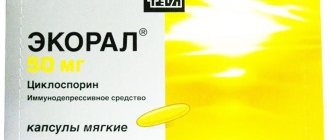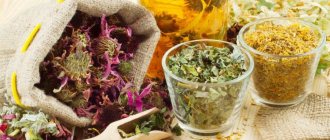Synonyms: Hepeel
"Hepel" is a homeopathic medicinal product that is used in the treatment of pathologies of the liver and biliary tract (GBD). This medicine is sublingual homeopathic. Used to treat diseases of the hepatobiliary system.
The medicine has the following pharmacological effects:
- antidiarrheal;
- choleretic;
- relieving inflammation and spasms;
- hepatoprotective (normalization of liver function).
Hepel is a multicomponent remedy, the effect of which is caused by the components that make up it.
The tablets are sold without a prescription. The manufacturer is Germany.
Composition of the drug Hepel
The table shows the components that make up the drug Hepel:
| Name | Content in one tablet (in grams) |
| Main components: | |
| 0,09 |
| 0,03 |
| 0,06 |
| 0,03 |
| 0,015 |
| 0,03 |
| 0,015 |
| 0,03 |
| Additional substances | Magnesium stearate, lactose |
Similar drugs
The selection of an analogue should only be carried out by a specialist. Analogues of the drug are such drugs as:
Galstena, Ursodez, Hepatrofit, Urocholum, Hepatoclin, Vitagepar, Bongigar, Gepanese, Ursofalk, Livodex, Benzylpenicillin, Urso 100, Berberis-homaccord, Sulfalene, Hepatoget, Ukriliv, Ursosan, Ovesol, Hepatofite, Tishok, Ursodex, Hepatomax, Livonorm, Ge pacef , Ursor, Ursoliv, Holiver, Ursohol, Urdoxa, Hepabene, Hepalex, Milk thistle, Urolesan, Chofitol, Potassium Orotate.
Pharmacological properties
Since Hepel consists of plant components, it is classified as a homeopathic remedy. Below are the medicinal properties of the plants that make up the medicine:
| Name | Therapeutic effect |
| Citrullus colocynthis (common colocynth) | Eliminates spasms in the bile ducts and intestinal walls. |
| Lycopodium clavatum (club moss) | It has a therapeutic effect on diseases of the liver, gall bladder and ducts, diseases of the skin, nervous system, and digestive organs. |
| Veratrum album (white hellebore) | It has an antifungal and analgesic effect, and also helps lower blood pressure, normalize heart function, and treat nervous disorders. |
| Chelidonium majus (greater celandine) | Promotes the disappearance of stones in the bile ducts, has a therapeutic effect against chronic diseases of the gallbladder, liver, and bile ducts. |
| Phosphorus (phosphorus) | Promotes restoration of the body when it is depleted, has a therapeutic effect against nervous disorders, diseases of the digestive organs, and severe infections. |
| Cinchona pubescens (cinnamon tree) | Eliminates biliary colic, skin rashes of various types, dyspepsia, and also restores the body when it is depleted. |
| Silibum marianum (spotted milk thistle) | It has a therapeutic effect against hemorrhoids, diseases of the liver, bile ducts and bladder caused by various stagnations in the body. |
| Myristica fragrans (fragrant nutmeg) | Fights inflammation, improves immunity, destroys microbes, normalizes sleep, stimulates the formation of bile and bile secretion, has antispasmodic, anti-inflammatory, warming, tonic, analgesic, choleretic effects |
Hepel
Do you know that:
Human bones are four times stronger than concrete.
Human blood “runs” through the vessels under enormous pressure and, if their integrity is violated, it can shoot at a distance of up to 10 meters.
According to WHO research, talking on a mobile phone for half an hour every day increases the likelihood of developing a brain tumor by 40%.
Over the course of a lifetime, the average person produces no less than two large pools of saliva.
The well-known drug Viagra was originally developed for the treatment of arterial hypertension.
The human stomach copes well with foreign objects without medical intervention. It is known that gastric juice can even dissolve coins.
An educated person is less susceptible to brain diseases. Intellectual activity promotes the formation of additional tissue that compensates for the disease.
You are more likely to break your neck if you fall off a donkey than if you fall off a horse. Just don't try to refute this statement.
The rarest disease is Kuru disease. Only members of the For tribe in New Guinea suffer from it. The patient dies of laughter. The disease is believed to be caused by eating human brains.
Scientists from Oxford University conducted a series of studies in which they came to the conclusion that vegetarianism can be harmful to the human brain, as it leads to a decrease in its mass. Therefore, scientists recommend not completely excluding fish and meat from your diet.
The human brain weighs about 2% of the total body weight, but it consumes about 20% of the oxygen entering the blood. This fact makes the human brain extremely susceptible to damage caused by a lack of oxygen.
Even if a person's heart does not beat, he can still live for a long period of time, as the Norwegian fisherman Jan Revsdal demonstrated to us. His “engine” stopped for 4 hours after a fisherman got lost and fell asleep in the snow.
Dentists appeared relatively recently. Back in the 19th century, pulling out diseased teeth was the responsibility of an ordinary hairdresser.
The cough medicine “Terpinkod” is one of the top sellers, not at all because of its medicinal properties.
74-year-old Australian resident James Harrison has donated blood about 1,000 times. He has a rare blood type whose antibodies help newborns with severe anemia survive. Thus, the Australian saved about two million children.
Indications for use of the drug Hepel
Hepel is prescribed for the treatment of:
- skin diseases,
- liver diseases caused by inflammation and toxic factors,
- biliary tract diseases,
- chronic colitis,
- dysbacteriosis,
- inflammation of the small intestinal mucosa of a chronic nature,
Sometimes Hepel is prescribed for decreased appetite, acne, polyarthritis, eczema, increased gas formation, and liver pathologies in children.
In addition, medication may be prescribed to normalize bilirubin levels.
Reviews
Among the reviews there are positive and negative opinions. Some write that the drug copes with the task perfectly. However, when purchasing, people experienced difficulties due to the lack of product in the pharmacy. Others noted that the drug is useless, because Does not help.
Among the negative aspects, people noted the high cost of the medicine.
On forums for young mothers you can often find reviews about taking the drug Hepel. Moms write that the medicine effectively eliminates dysbiosis, jaundice, and painful sensations. and also normalizes the baby’s stool.
Instructions for use of the medicine Hepel
According to the instructions, the patient should take one Hepel tablet 3 times a day. Moreover, it is recommended to do this long before meals, since in this case the medicine has a more pronounced effect. Take the tablets with plenty of water.
If adverse reactions occur, you should consult a doctor.
It is worth noting that Hepel does not have a negative effect on the nervous system.
Instructions for use
The instructions contain information about indications, side effects, and contraindications.
It is imperative that you familiarize yourself with this data so as not to encounter unpleasant consequences in the future.
Pharmacology
Hepel is a multicomponent homeopathic medicine. Its effect is due to the components that make up the medicine.
Indications
Reviews from doctors about this medicine indicate that Hepel should be taken as part of a comprehensive liver treatment. The drug is popular in the treatment of diseases such as:
Bile duct dyskinesia;- Hepatitis (acute as well as chronic form);
- Inflammation of the gallbladder, which is chronic;
- Cholangitis, liver cirrhosis, enteritis, colitis, which are in a chronic form;
- Increased flatulence;
- Increased level of cholesterol in human blood.
In addition, the drug can be prescribed to children who have been diagnosed with a non-infectious form of jaundice.
Mode of application
The tablet form of the drug should be taken by placing the tablet under the tongue until it is completely dissolved.
The tablet should be taken 60 minutes after eating or on an empty stomach 15 minutes before starting a meal. The dosage in each individual case is selected individually, however, as a rule, it is no more than 1 tablet 3 times a day.
For children under 3 years of age, the dosage should be 1/4 of a tablet, which should first be ground into powder and dissolved in 1 tsp. water. Children over 3 years old can already use the adult method of taking the pill.
The Hepel solution If the patient has a severe course of the disease, then the medicine should be administered 1 ampoule per day. The drug must be administered daily. After improvements have been recorded in the patient, the medicine is administered 1 ampoule 1-2 times a week.
Release form
In pharmacies you can find two forms of release of the drug Hepel:
- Pills . This form of the medicine has a white-orange tint and no odor. The package may contain 50 or 250 tablets;
- Injection . The solution is a clear liquid that is tasteless and odorless. The package may contain 5, 10, 50, or 100 ampoules.
The tablet contains greater celandine, cinchona, milk thistle, nutmeg, white wild cherry, phosphorus, common colocynth, club moss, as well as magnesium stearate and lactose.
The solution contains clavate swimmer, Nux moschata, Chelidonium, Phosphorus, Veratrum, Carduus marianus, Colocynthis, as well as water for preparing injections.
Interaction
Doctors recommend that before starting to take any medication, you should inform your specialist that you are taking other medications. The drug Hepel can be combined with other drugs, because no clinically significant changes occur.
However, when taken simultaneously with hepatotoxic drugs, the decision to take the drug Hepel is selected individually in each case.
Side effects
Since Hepel consists of plant components, undesirable reactions from the body are likely to occur, namely:
- increase in bilirubin to the level of development of jaundice,
- skin allergies,
- increased liver transaminases,
- fever.
After stopping the medication, blood counts usually return to normal. However, if any of the above reactions occur, you should consult a doctor.
Directions
In this section, some patients will be able to find some important information for themselves.
Driving
If you are taking this drug, you should avoid driving long distances.
Pregnancy
Doctors have no information about the use of the medicine in pregnant or lactating women. This is why many doctors prohibit using it to treat diseases in women who are pregnant.
If there is a need to take medication during breastfeeding, then the natural method of feeding should be abandoned.
Childhood
Taking the medicine is not allowed under 18 years of age.
Welcome to senior citizens
Dosage adjustment is required.
For kidney problems
Medication may be prescribed with caution.
Reception for impaired liver function
Used according to indications.
Release from pharmacy
Strictly according to the recipe.
Compatibility of alcohol and drugs
During treatment, it is best to quit smoking and completely eliminate alcohol.
Composition and release form
The medication contains a whole list of active ingredients:
- Lycopodium clavatum - used in the treatment of diseases of the digestive system, liver, gallbladder and allergies. Helps normalize the nervous system.
- Chelidonium majus – helps with stones in the bile ducts.
- Cinchona pubescens – helps with colic, indigestion, dyspeptic pathologies and allergies.
- Myristica fragrans – normalizes the process of flatulence, a healing component in the treatment of gastrointestinal pathologies (gastrointestinal tract).
- Silybum marianum – helps in the fight against diseases of the hepatobiliary system.
- Phosphorus – suitable for normalizing the digestive system, body weakness and infections.
- Veratrum album – helps with diarrhea, neuralgia, heart failure.
- Citrullus colocynthis – reduces cramps in the intestines and biliary tract.
The composition also contains compounds that contain lactose and magnesium stearate (additive substances).
Thanks to all components, the drug has a hepatoprotective effect. It increases the liver's resistance to various harmful influences. It also has antispasmodic and choleretic properties, and relieves inflammation. Suitable for people with poor digestion, polyarthritis, and bloating.
The medicine is available in pill form. Each container contains 50 tablets, which are white with a beige or orange tint. To us they look round, and the surface is flat-cylindrical. The tablets also have dotted spots with an orange tint.
The medicine is produced in a polymer container, packed in a cardboard box along with instructions.
The drug is additionally prepared in the form of drops. The components and properties are exactly the same as those of the tablets.
Side effects and contraindications
The main restrictions for the use of the drug include:
- expecting a baby and lactation period;
- individual intolerance to any component included in the drug;
- hypersensitivity to quinine;
- under eighteen years of age without complete medical facts;
- lactose intolerance;
- lactase deficiency;
- glucose-galactose malabsorption.
If there is hypersensitivity to any component, a rash or fever may occur (rare cases). If such symptoms occur, you must immediately stop using the medicine. Also, when taking this drug simultaneously with products containing celandine, an increase in bilirubin or transaminases in the blood is possible. After stopping the course of treatment, all indicators return to normal.
Use for children
Children over 12 years of age are prescribed one tablet three times a day under the tongue. A child under 12 years of age is prescribed 1 tablet, which must be ground into a mixture and dissolved in liquid. The water should be boiled and at room temperature. Use 3 times a day, following the age-specific dosage.
Age dose for a child:
- up to twelve months – one teaspoon (1/4 tablet);
- from one year to six years – 2 tsp;
- from six to twelve years – 3 tsp.
Store the remaining medicinal solution for no more than a day in a room at room temperature and a minimum amount of light.
The age-specific dosage should be taken 3 times a day before meals or an hour after meals. If the period of illness is acute, take a dose every 15 minutes for the first 2 hours. Then switch to using 3 times every 24 hours.
The course of homeopathy for acute illness is 7-14 days, for chronic illness – from 2 to 6 weeks.
The dosage and duration of treatment will be prescribed by the doctor. You should not self-medicate.
